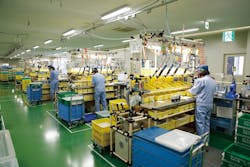Much of what you hear about automation focuses on the increased productivity that automation can bring to production lines. You hear about this a lot because it’s a true, measurable reality.
But is it possible that too much reliance on automation can hinder the overall productivity of a factory?
At Mitsubishi Electric´s Kani manufacturing facility, which is part of the company’s Nagoya Works in Japan, the company found that, by bringing humans into work cells that were once 100 percent automated, the footprint occupied by the cell itself could be reduced by 84 percent. A single line that previously occupied 280 square meters when fully automated has been reduced to 44.1 square meters after redesigning it to accommodate human interaction in the production process, according to Mitsubishi Electric. This workspace reduction translates into an increase in utilization of each square meter of production in the facility.
In addition, Mitsubishi Electric notes that the introduction of human workers to previously automated assembly lines is helping the Kani factory react faster to changes in product demand.
Discovering the problem
The Kani factory produces motor starters and contactors for Mitsubishi Electric. The vast amount of production variations and possible configurations of these products—14,000—diluted the volumes of each particular product. This amount of variability, coupled with customer demands for even greater choice, highlighted the automation problem for Mitsubishi Electric.
According to the company, manual production at the Kani factory had given way to totally automated assembly lines, which were ideal for mass production with few product variations where high yields could be realized at high speed. But this required many individual components to be held in stock and ready for the manufacturing process; otherwise, the lines would not be able to run for any appreciable length of time.
In effect, it became difficult and uneconomical for the factory to produce its products in small batches—which just happens to be the very direction in which industry as whole is headed.
Addressing the issue with the e-F@ctory Alliance, CC-Link Partners Association, and other collaborative engineering groups led Mitsubishi Electric to a re-evaluation of its totally automated lines. The company realized that, by restoring some human elements, it could reduce some of the manufacturing problems it was encountering.
For example, analysis of the totally automated workcells showed that the automated parts feeding of some of the larger components created a bottleneck which resulted in some damage to the components. Though this damage was relatively minor and did not cause a specific production issue, Kani engineers were dissatisfied with the quality level being produced. Having humans manage the parts feeding process eliminated the bottleneck and the resulting quality defects.
Greater efficiency
During this study of the automated processes at Kani, while some steps—such as the automated parts feeding—were revisited with human interaction, other tasks that were once thought to be too difficult to automate now appeared ripe for new automation approaches to improve the process. One example of this dealt with the misalignment of certain screws during the assembly process. According to Mitsubishi Electric, the automation system, unaware of the misalignment, would still try to insert the screw and cause damage to the entrance of the hole.
This problem was addressed with two technologies: 1) the automatic alignment of robots; and 2) combining rotational drives for inserting the screws using torque sensors. Screw holes can now be located easily and aligned correctly every time; and the torque sensor confirms the absence of misalignment and that the screw is tightened to the correct level. The company’s increased use of vision systems has also helped increase the number of right-first-time products.
Despite that fact that the new cells, featuring a combination of human workers and automation, cannot produce at the same volume and speed as the fully automated lines, the reduced size of the new cells means the company can deploy up to 6.3 cells in the same space once occupied by one cell. Mitsubishi Electric says this means that total productivity density for the facility is much higher due to three key factors: a wider variety of products can be manufactured in smaller batches; one stoppage does not halt the whole of production; and the total number of production lines has increased.
About the Author
David Greenfield, editor in chief
Editor in Chief

Leaders relevant to this article:
